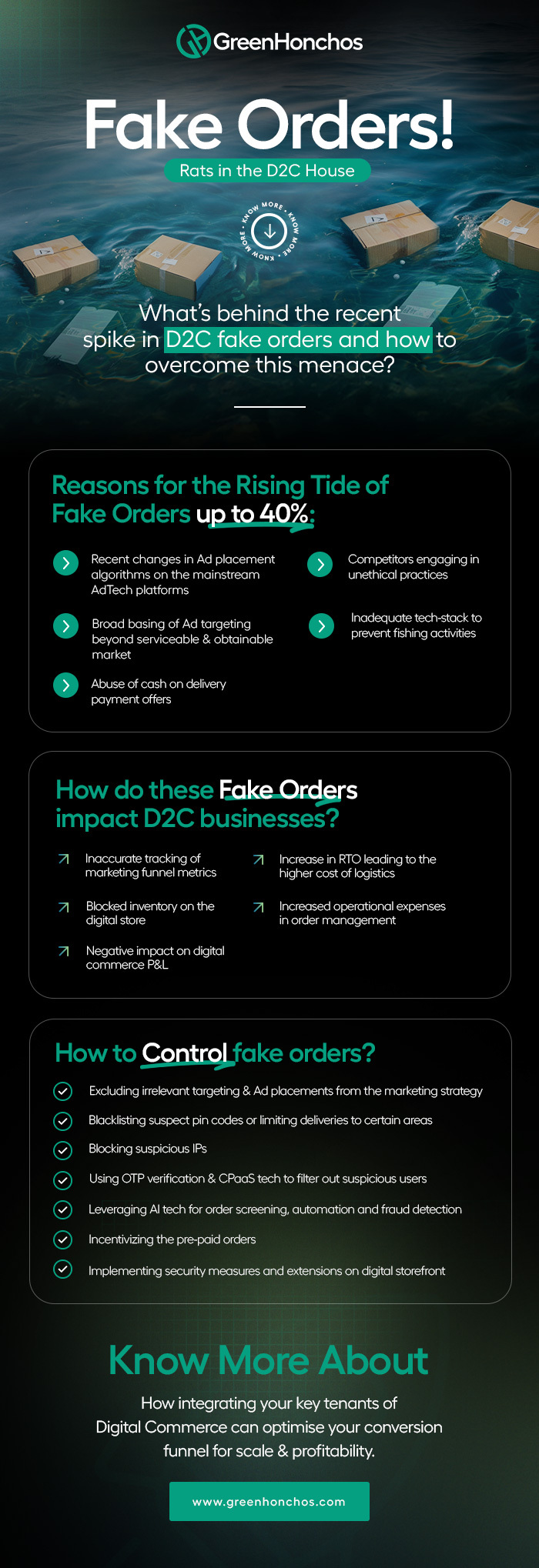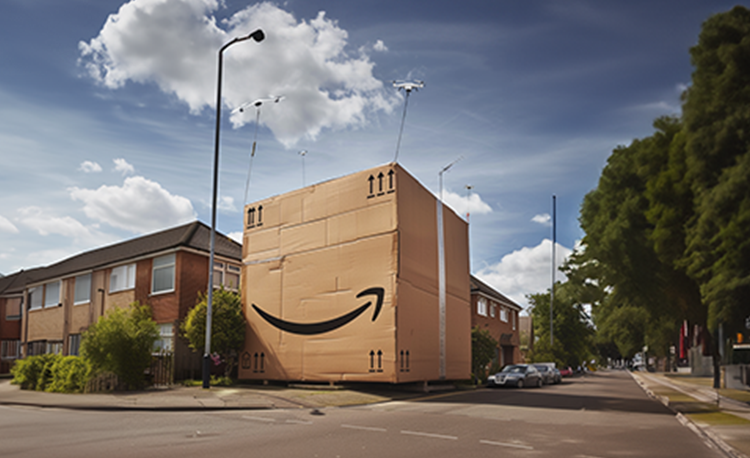Where to bid your money? Digital Marketing v/s Traditional Marketing
Marketers since generations have banked heavily on the traditional means of marketing for the share…
In the fast-paced eRetail sector, differentiating the real vs fake orders is increasingly becoming a major obstacle to brand growth and profitability. These fake orders not only tie up valuable inventory but also redirect brand resources from serving legitimate customer needs. Research conducted by GreenHonchos has revealed a concerning surge of up to 40% in fake orders over the past year, which has negatively impacted both the supply chain and revenue of brands.
Even leading marketplaces are not immune to this common practice, which significantly impacts their credibility and the expectations of their sellers. To address this issue, major marketplace platforms like Amazon have assembled a dedicated team of 15,000 professionals, including machine learning scientists, software developers, and expert investigators. In 2023, Amazon invested over $1.2 billion to resolve this problem and safeguard the interests of brands, sellers, and genuine customers from these fraudulent activities.
As a foremost digital commerce enabler for 200+ global retail brands, our team was compelled to investigate the reasons behind the surge in fake orders within the D2C sector, implement security measures, and plug the leaking bucket. Our goal was to assess the impact on D2C brands across categories and offer proven, practical solutions to counteract these challenges without any loss of revenue opportunities. Let’s delve deeper into the findings and strategies.
Before exploring solutions, it is crucial for a brand to understand the underlying factors contributing to the rise in such orders. Fake orders in the D2C sector can be attributed to several factors:
This is a prevalent cause of the increase in fake orders. However, halting promotions isn’t an option as they are integral to online growth strategies. While promotions aim to increase sales, they can sometimes backfire when exploited by fishy digital shoppers. Such individuals or groups may place large orders under promotional offers with no intention of retaining the products, leading to substantial losses for the eCommerce brand.
Occasionally, adjustments to ad placement algorithms on major AdTech platforms or ads that target the broad-level spray-and-pray audience can result in a spike in fake orders. This happens because the targeted audience may lack a genuine interest in the product. Such technical oversights or misplacements can lead to an increase in fake orders, which can significantly impact the brand on a larger scale.
Many customers opt for cash on delivery (COD) when purchasing online, particularly those who prefer not to use digital payment methods, rely on transactions at physical delivery of the product or are not sure about buying the product eventually. Brands offer COD options from the perspective of offering convenience to make the buying journey easy for customers. However, a common issue arises when such customers cancel their orders upon delivery, often because they have low intent of buying, have lost interest in the purchase, or aren’t bound by monetary liability, albeit temporarily. This behavior leads to a rise in fake orders, which negatively impacts the brand’s return on investment (ROI). Such incidents are particularly frequent during festive seasons, exacerbating the challenges for retailers.
Some Pin Codes especially in regions with poor logistics infrastructure are more prone to bulk fake orders. Customers might place bulk orders or attempt to order large quantities, which could raise red flags. These bulk orders are often suspect, particularly if they are not prepaid. Certain regions have a higher incidence of such fraudulent activities, which can financially strain a retail brand due to the associated shipping costs and chargebacks from these substantial fake orders.
Although rare, this malpractice involves competitors engaging in sabotage by placing fake orders to deplete the resources of a rival brand. Driven by unethical intent, these competitors resort to such tactics to sow panic among their rivals, aiming to capitalize on this disruption, particularly during sales seasons.
Various underlying factors can contribute to the prevalence of fake orders, varying by industry or specific brand characteristics. Notably, when customers choose Cash on Delivery (COD) over prepaid options, the likelihood of returns to origin (RTO) increases significantly. This scenario poses substantial operational challenges for eCommerce brands, leading to increased logistics costs, inventory blockages, and reduced true conversion rates and profitability.
The consequences of fake orders extend beyond just financial losses. Here are a few ways that a brand gets affected by fake orders:
Fake orders often result in increased RTO, placing significant strain on brands as they navigate both forward and reverse logistics. Handling these returns can become costly and inefficient, leading to substantial financial losses and operational difficulties for brands on a larger scale.
Fake orders result in inventory blockages as products remain stuck in transit, unavailable for purchase by genuine customers. This malpractice not only causes lost sales opportunities but also incurs additional holding costs, ultimately impacting revenue generation negatively.
Fake orders lead to a costly and time-consuming cycle, where items returned due to RTO must undergo inspection and potentially be repackaged, increasing operational demands. Ultimately, these processes result in financial losses that the brand must absorb, compounding the negative impact of fake orders.
Certain products are particularly susceptible to damage, especially those exposed to the risks of multiple shipments. This heightened risk of damage not only impacts the brand’s operational costs but also leads to financial losses as a result of increased product handling.
D2C brands can adopt several strategies to combat the issue of fake orders:
D2C brands have the option to blacklist suspected Pin Codes or restrict deliveries to specific areas known for a high incidence of fake orders. This strategic approach can effectively minimize fraud risks from these high-risk regions.
Brands should implement additional security measures throughout the online customer journey such as blocking suspicious IPs and using OTP verification, which can help in distinguishing fraudulent orders from legitimate ones.
Numerous global eRetail brands are adopting advanced technologies such as AI to automate and refine the process of order screening and fraud detection, significantly improving the precision with which fake orders are identified.
Brands can leverage use behavior data to establish stricter COD eligibility criteria and excluding third-party checkout options for COD orders can diminish the risk of fraud. It will eventually help them to control fake orders demographically especially bulk orders.
D2C brands should regularly update security protocols and monitor ordering patterns can help them stay ahead of fraudulent tactics and act proactively.
Have a look at our detailed infographic and learn more about how to control fake orders!

The surge in fake orders is a complex issue that D2C brands must address proactively to safeguard their interests and maintain customer trust. By understanding the mechanisms behind such frauds and implementing robust strategies to counter them, brands can not only protect their revenues but also enhance their market credibility. It’s a continuous battle, but with the right tools and approaches, success is within reach for brands committed to maintaining a secure and trustworthy eCommerce environment.
By working with the top digital commerce enabler and incorporating these measures, retail brands can significantly reduce the incidence of fake orders online, thereby protecting their revenue and reputation in an increasingly competitive market. The key lies in a proactive approach, leveraging technology, and maintaining strict controls over the ordering and delivery processes.
Using digital marketing strategies can drastically increase your brand awareness which ultimately leads to more sales and repeat business. Looking for a Digital Marketing agency that understands the needs of your D2C eCommerce? Check out GreenHonchos – a Full-Stack D2C enabler offering services like growth marketing, eCommerce digital marketing, marketplace management, social media marketing and much more! For more valuable insights on eCommerce marketing and D2C growth strategies, follow us on LinkedIn , Facebook , Instagram and Twitter or visit our website .

As Henry Ford wisely said, “The only real mistake is the ...


For many years, July was often considered a slow month for r...


With the overall increase in global retail sales figures, th...


In the...


In the...


The Indian eCommerce industry is transforming at a faster pa...


It’s been a while since Meta introduced its contender to T...


Marketing your brand at Amazon can exponentially boost your ...


The pandemic has brought about a lot of changes and ada...


There is no denying the fact that marketplaces have bee...


The post-pandemic world has made brands realise the importan...


We are living in a digital age where every brand is coming a...


Digital media accounted for 64.4% of global ad sp...


Marketers since generations have banked heavily on the ...


Social Media has grown rapidly in the past couple of years. ...


The first step towards building a successful business i...

Want to take your eCommerce business to the next level? We help businesses make the most at every stage - from product conceptualization to achieving the maximum optimization & ROI on business operations.
B-24, Sector 3, Noida, GB Nagar,
Uttar Pradesh 201301, India
Mazaya Business Avenue, Tower AA1,
FZCO, Office #18, 36th floor, JLT, Dubai, UAE
1st Floor, Plot-183, Indiranagar Stage 2,
Bengaluru, Karnataka,
560038, India